The OCZ Trion 150 SSD Review
by Billy Tallis on April 1, 2016 8:00 AM ESTATTO
ATTO's Disk Benchmark is a quick and easy freeware tool to measure drive performance across various transfer sizes.
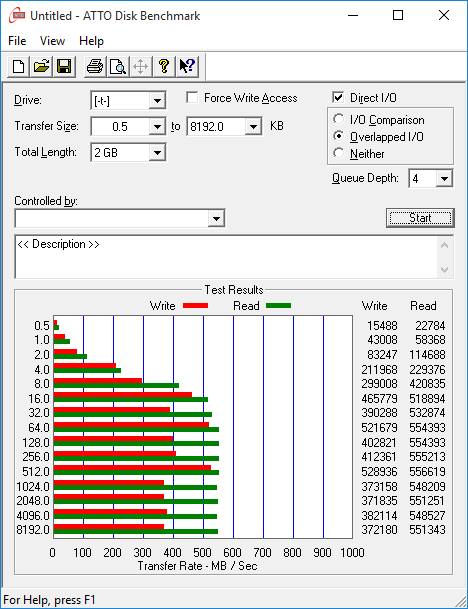 |
|||||||||
The 240GB Trion 150's write speeds are a bit uneven, but the larger capacities are perfectly normal with write speeds that are only slightly behind read speeds.
AS-SSD
AS-SSD is another quick and free benchmark tool. It uses incompressible data for all of its tests, making it an easy way to keep an eye on which drives are relying on transparent data compression. The short duration of the test makes it a decent indicator of peak drive performance.
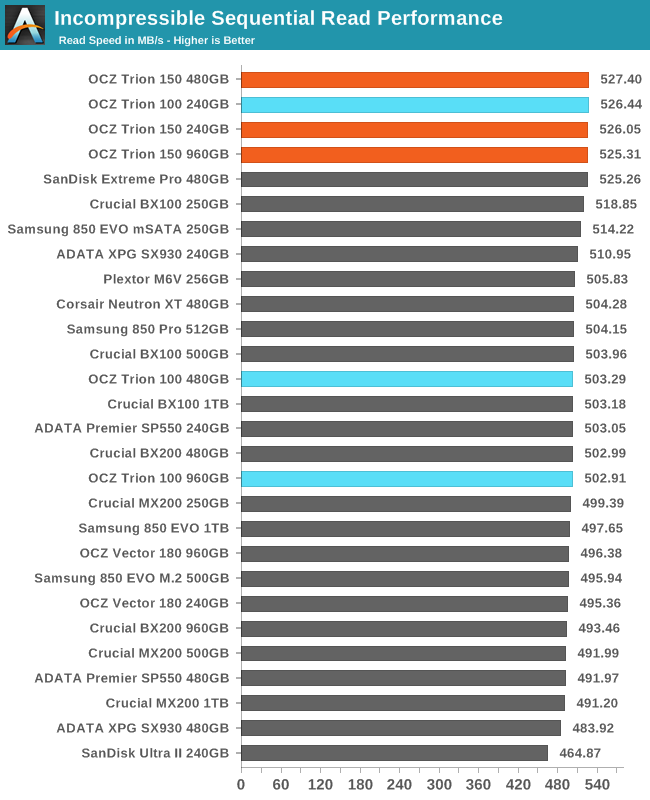
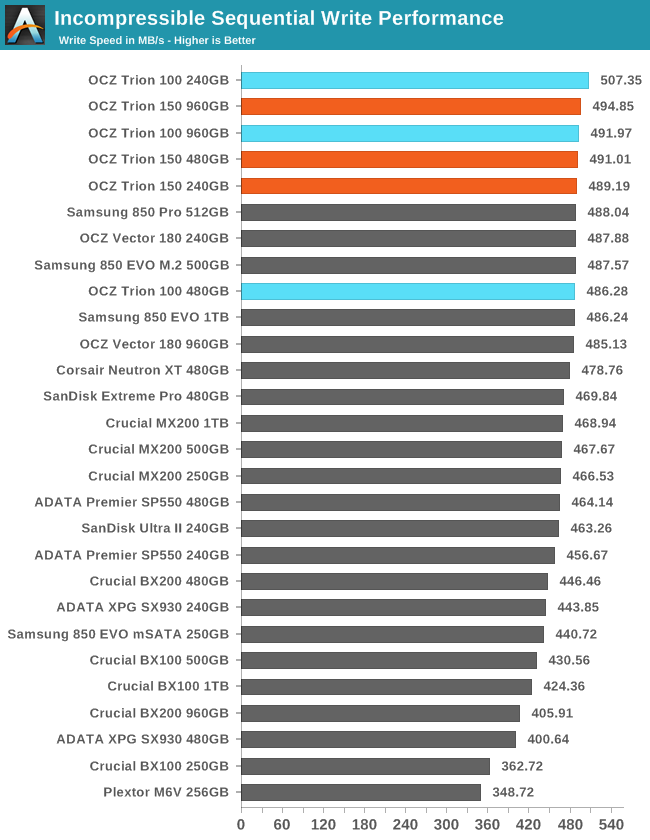
The Trion 150 manages to mostly top the (SATA) charts for peak read and write speeds, but the distinction is meaningless given how close the competition is.
Idle Power Consumption
Since the ATSB tests based on real-world usage cut idle times short to 25ms, their power consumption scores paint an inaccurate picture of the relative suitability of drives for mobile use. During real-world client use, a solid state drive will spend far more time idle than actively processing commands. Our testbed doesn't support the deepest DevSlp power saving mode that SATA drives can implement, but we can measure the power usage in the intermediate slumber state where both the host and device ends of the SATA link enter a low-power state and the drive is free to engage its internal power savings measures.
We also report the drive's idle power consumption while the SATA link is active and not in any power saving state. Drives are required to be able to wake from the slumber state in under 10 milliseconds, but that still leaves plenty of room for them to add latency to a burst of I/O. Because of this, many desktops default to either not using SATA Aggressive Link Power Management (ALPM) at all or to only enable it partially without making use of the device-initiated power management (DIPM) capability. Additionally, SATA Hot-Swap is incompatible with the use of DIPM, so our SSD testbed usually has DIPM turned off during performance testing.
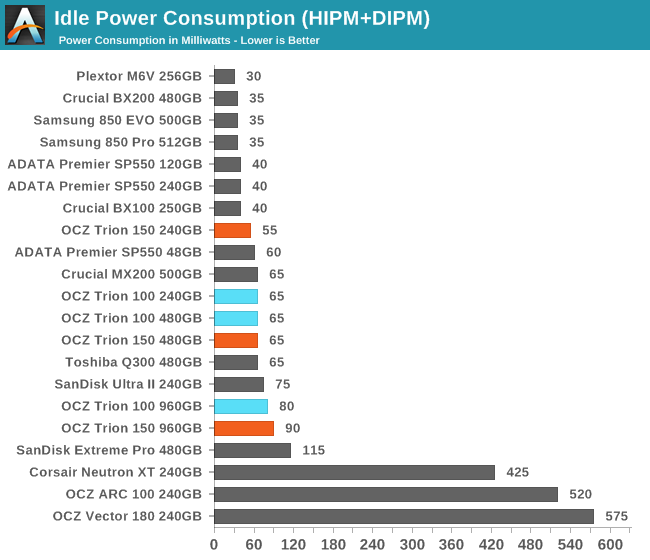
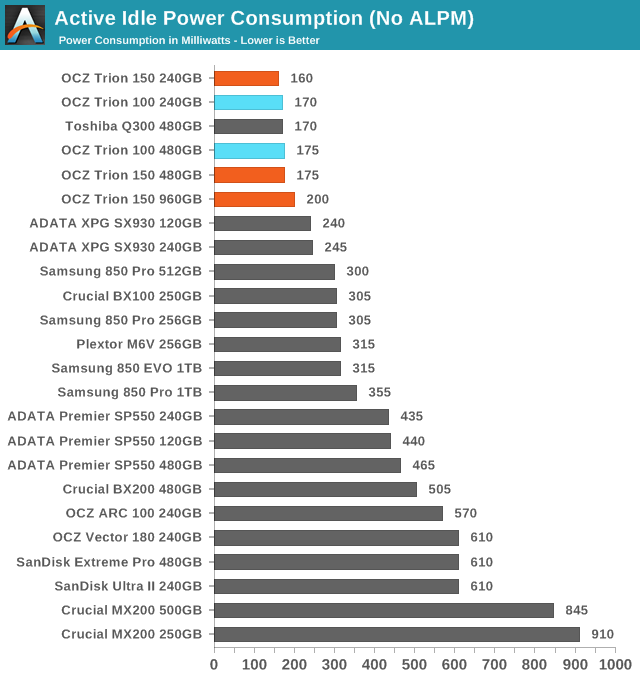
With and without DIPM, the Trion 150 has similar idle power consumption to its predecessors based on the TC58 controller. It's the best at saving power when ALPM is unavailable, and its device-initiated power management works properly.










79 Comments
View All Comments
ocztaec - Tuesday, April 5, 2016 - link
Hi Arnulf,As this is my first post on this article please allow me to identify myself as a Toshiba America Electronic Components (TAEC) representative. We completely understand the quality concerns and appreciate your comments. Since the Toshiba acquisition of OCZ in 2014 improving product reliability is a key priority for us. We made significant changes to everything from processes to production. OCZ SSDs are made with premium Toshiba NAND and is back by the Advanced Warranty Program.
We understand how you feel and hope that one day we will have the opportunity to demonstrate the reliability of current OCZ products. Thank you again for your feedback.
nathanddrews - Friday, April 1, 2016 - link
Not a great showing, that's for sure. I'd like to point out two things - one is that we're looking at a range of drives that could be offering 2TB SSDs for under $400. WhereTF are they? I feel like we've been pretty patient, but at these prices, I can actually afford to replace all disks on my PCs and getting really close to replacing disks on my servers and NAS units.Second, would it be at all reasonable to add a WD VelociRaptor, Hybrid SSHD, and/or common 5400RPM hard drive to the 2015 SSD Bench like the old days? I think most of the readership knows how much better ANY SSD is over a mechanical HDD, but I think we also get a bit too cynical with drives like this that are "slow" compared to other SSDs and won't even consider buying them. We shouldn't forget where we came from. XD
tarqsharq - Friday, April 1, 2016 - link
I second this, really want to keep perspective on speeds, especially when we're dealing with the low cost SSDs where you can get high storage space for low $$ImSpartacus - Saturday, April 2, 2016 - link
Yeah, it would a fantastic way to gain context. Just don't worry about scaling the graphs for the hard drives if that ever becomes an issue.bug77 - Friday, April 1, 2016 - link
Have you seen the size increase of the PCB? There's no space for 2TB worth of chips.DanNeely - Friday, April 1, 2016 - link
Agreed, as stated in the 2nd paragraph of the article: "It's important to keep in mind that for the cheapest SSDs on the market, maximizing performance is not the only goal and often isn't even a primary goal." Yes, the performance sucks compared to anything the average Anandtech reader would put in his computer, but these drives are intended to get people who buy cheap crappy computers at the boxmark off of spinning rust. It might help if the performance charts were split between performance and budget SSDs, otherwise is as unfair as comparing a standard HDD to a 15k SAS drive would've been a dozen years ago.It's still probably 2 or 3 generations before I'd consider SSDing my NAS. Pricing even on cheap SSDs is still ~6x that of NAS HDDs; it'd need to drop to at most 2x before I'd consider it; at that point reduced power consumption over a half dozen years might be able to close enough of the gap that quieter operation and smaller size might be worth the larger up front cost. Also, I'd want at least 6gb of post RAID storage capacity if standing up a new NAS today; probably 10 or 12 if I'd be filling all the bays and unable to add more storage to it later; with my needs growing by about 2x every 3-4 years. The smaller criteria could be met by 4x2gb drives in raid 5; the latter would either need 4gb drives or an 8 bay enclosure. Pre-built 8-bay NASes suffer from an additional enterprise price premium; while on the DIY front that many sata ports is stretching what can be done with cheap hardware and I'm not aware of any mITX sized cases with that many drive bays.
bji - Friday, April 1, 2016 - link
Just curious, what do you do with all that storage? 10 to 12 TB (I assume your 6gb was a typo and you meant 6tb) is a hell of alot of storage. What do you need so much storage for?I am still using a first gen Macbook pro retina with 256 GB of SSD storage and I have 90 GB free. Even my server that does backups and stuff uses only about 350 GB.
DanNeely - Friday, April 1, 2016 - link
Media and system backups. About half of the latter is images of old systems that I got rid of at some point. Feeding bigger drives into the nas is a lot easier than trying to scour a system to make sure everything of value's been removed separately. Most recently some scanned documents a family member left in the scanner apps temp folder (that I didn't even know existed).bji - Friday, April 1, 2016 - link
What kind of media needs that much storage? Are you a professional videographer?Arnulf - Saturday, April 2, 2016 - link
P0rn :)